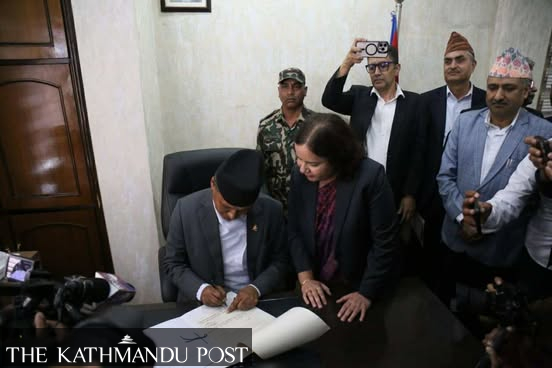National
Ghising takes charge of energy portfolio after leading Nepal out of energy crisis
Known for playing a key role in ending load-shedding, Kulman Ghising assumes responsibility for three ministries amid political turbulence.
Seema Tamang
Kulman Ghising, credited for playing a key role in ending hours-long daily power cuts a decade ago, has been appointed Minister for Energy, Water Resources and Irrigation, Physical Infrastructure, and Urban Development in Prime Minister Sushila Karki’s new Cabinet.
Ghising, former managing director of the Nepal Electricity Authority (NEA), is widely credited for declaring Kathmandu Valley load-shedding-free during the Dashain–Tihar festival in October 2016. By May 2018, he had extended this achievement nationwide, freeing the country from nearly 15 years of power rationing.
Public expectations of Ghising remain high. During his visits to the Gulf states earlier this year, Nepali workers expressed their trust in him to continue transforming the energy sector. Similar encouragement followed him during trips to the United States and Europe.
This new appointment comes at a critical moment. The KP Sharma Oli-led government sacked Ghising as NEA chief in March after prolonged dispute with then energy minister Deepak Khadka despite that Ghising was completing his tenure within months.
Ghising had pushed for collecting long-overdue payments of billions of rupees from industries for dedicated and trunk power lines by cutting supply if necessary—an approach opposed by Khadka.
The Council of Ministers led by Oli eventually dismissed him, despite his challenge in court. His second stint as NEA chief, which began on August 9, 2021 under prime minister Pushpa Kamal Dahal, was to end on August 9, 2025.
Born on November 25, 1970 in Bethan, Ramechhap, Ghising entered the NEA as an engineer in 1994. He rose through the ranks, becoming a director in 2014 after leading the Chilime Hydropower Company, where he played a central role in projects such as Rasuwagadhi, Middle Bhotekoshi, Sanjen, and Upper Sanjen. His technical background is supported by degrees in electrical engineering from India, a master’s in power systems from Pulchowk Campus, and an Executive MBA from Pokhara University.
On Monday afternoon, Ghising took office at Singha Durbar. His first directive was to the NEA: collect the long overdue payments from the industries for using dedicated and trunk line users, a task he had attempted earlier but was blocked by political interference.

The companies were provided dedicated electricity supply at a time when general people were reeling under hours-long power cuts.
Acknowledging the country’s fragile condition, Ghising said his acceptance of three ministerial portfolios was an act of responsibility rather than ambition.
“Nepal is at a critical juncture. This is not a challenge to run away from, but one to face,” he declared. “Our focus must be reconstruction, prosperity, and political stability. It is not the time for violence, but for solutions.”
Ghising’s reputation for discipline and reform is expected to be tested as he balances political pressures with urgent national priorities. Whether he can replicate his success in ending load-shedding on a broader developmental scale will determine his legacy as both a technocrat and now a politician.




 7.12°C Kathmandu
7.12°C Kathmandu















